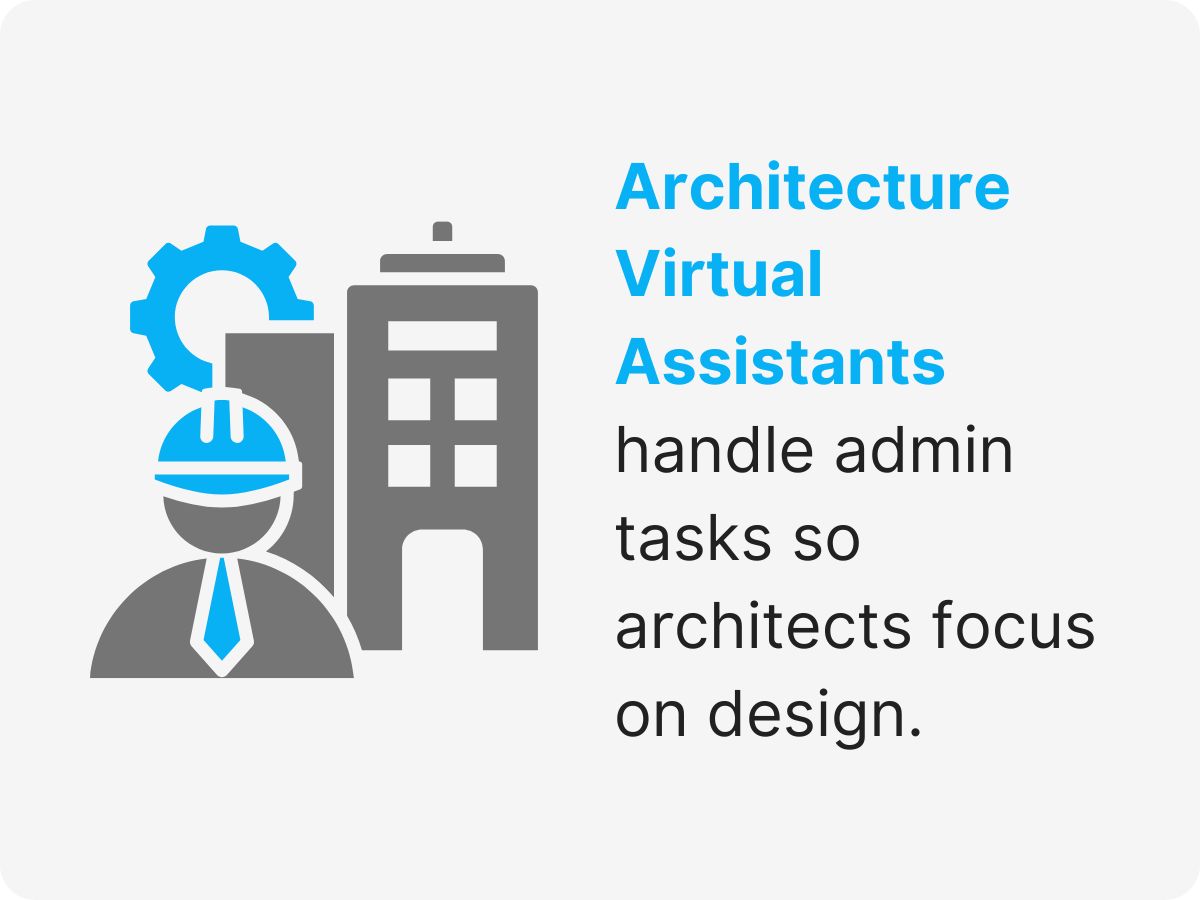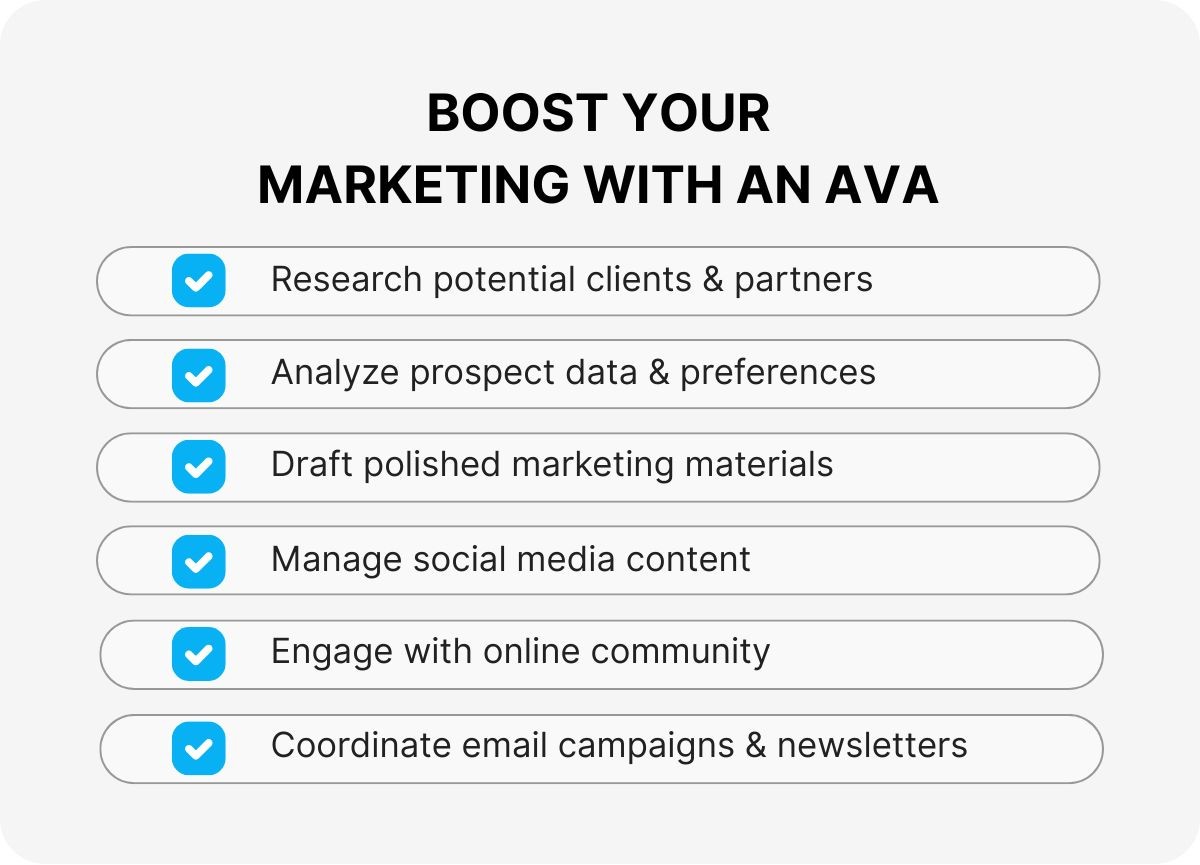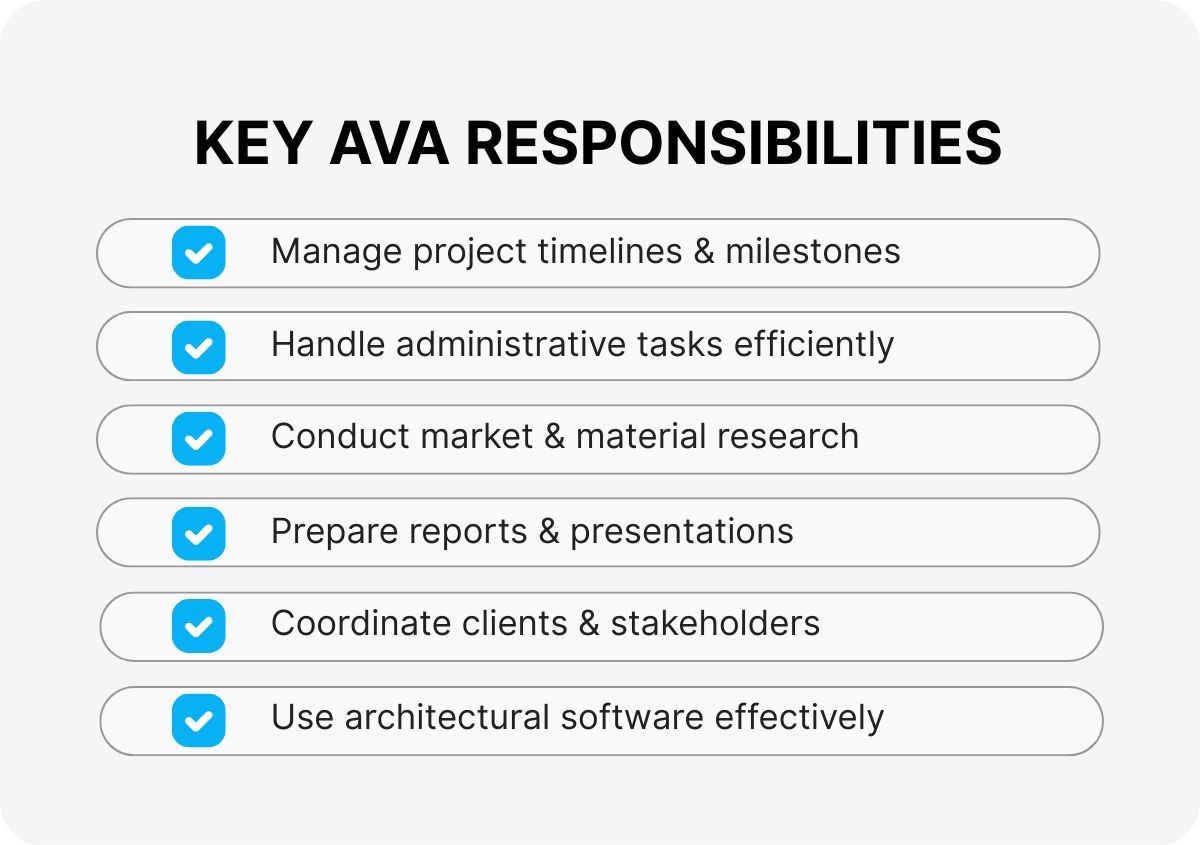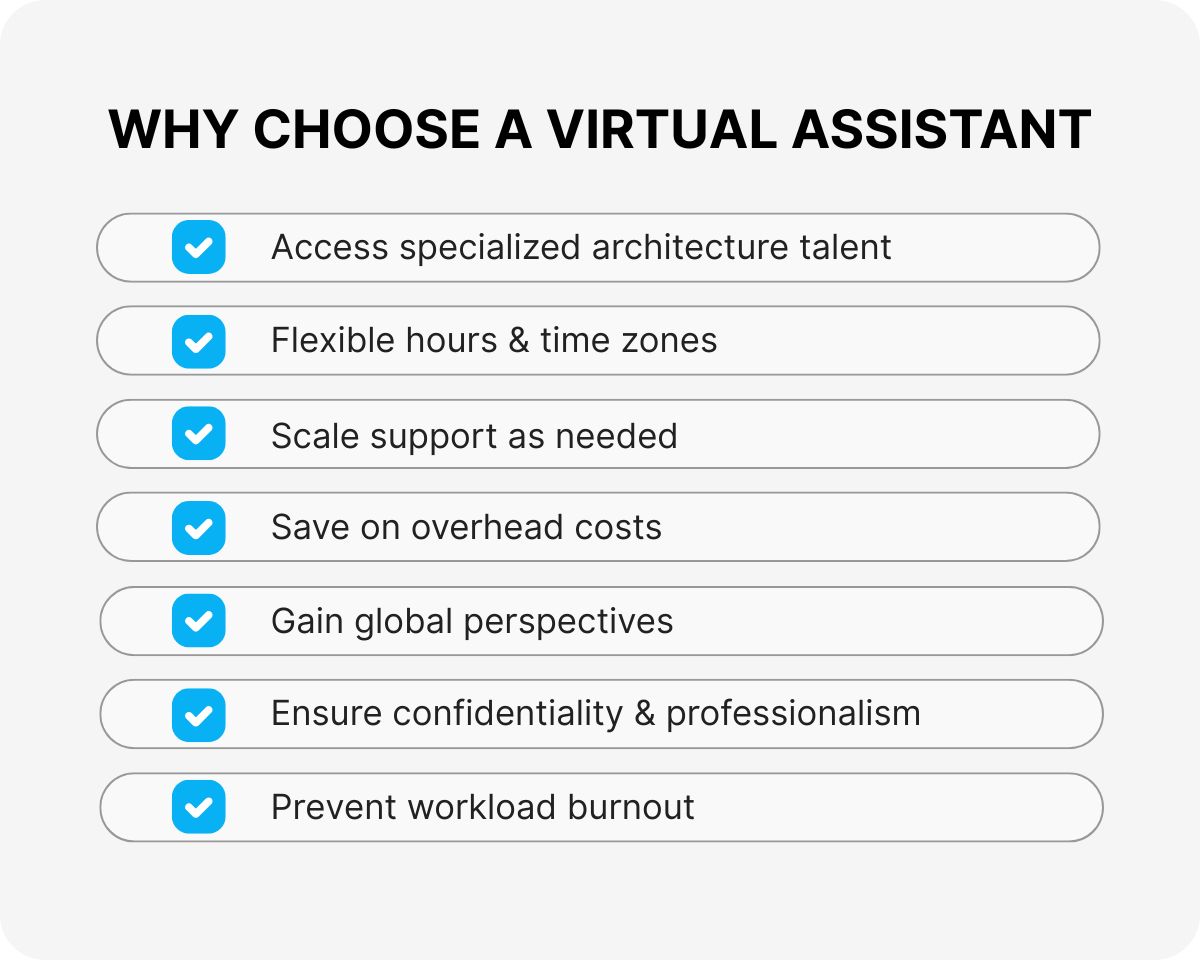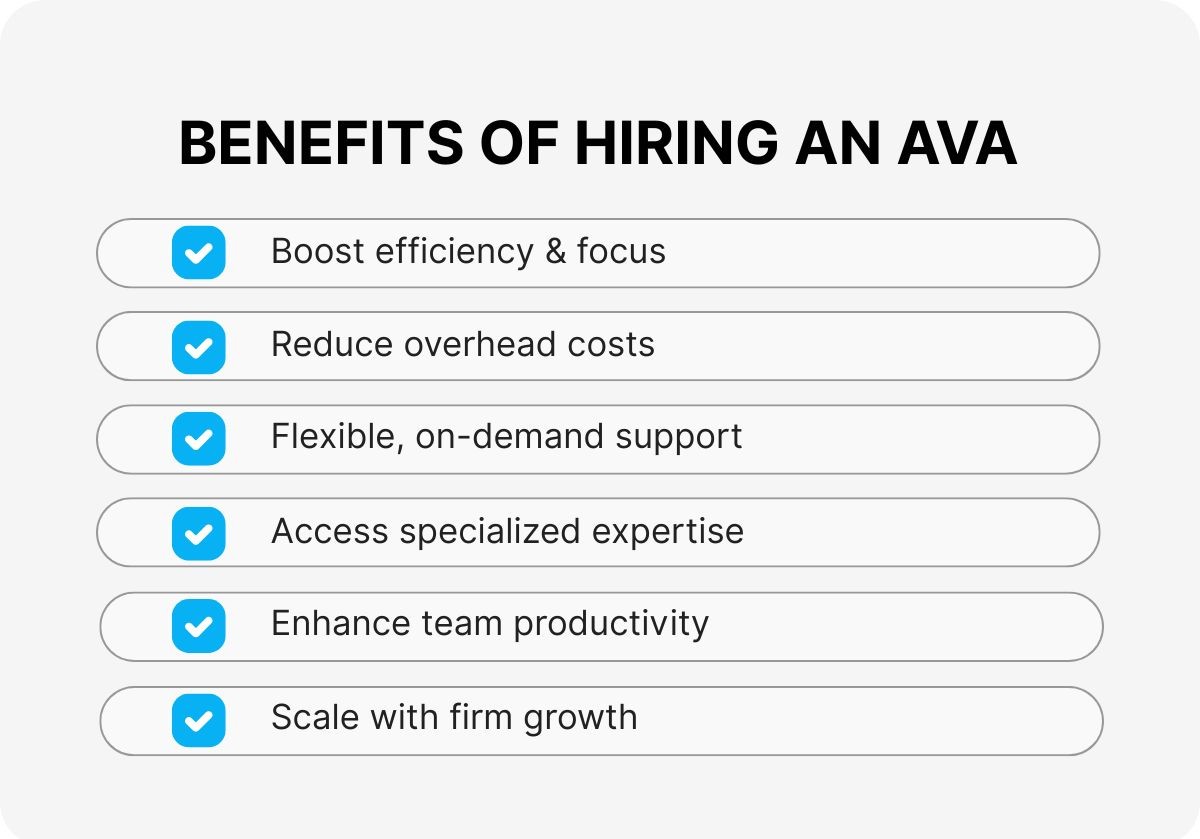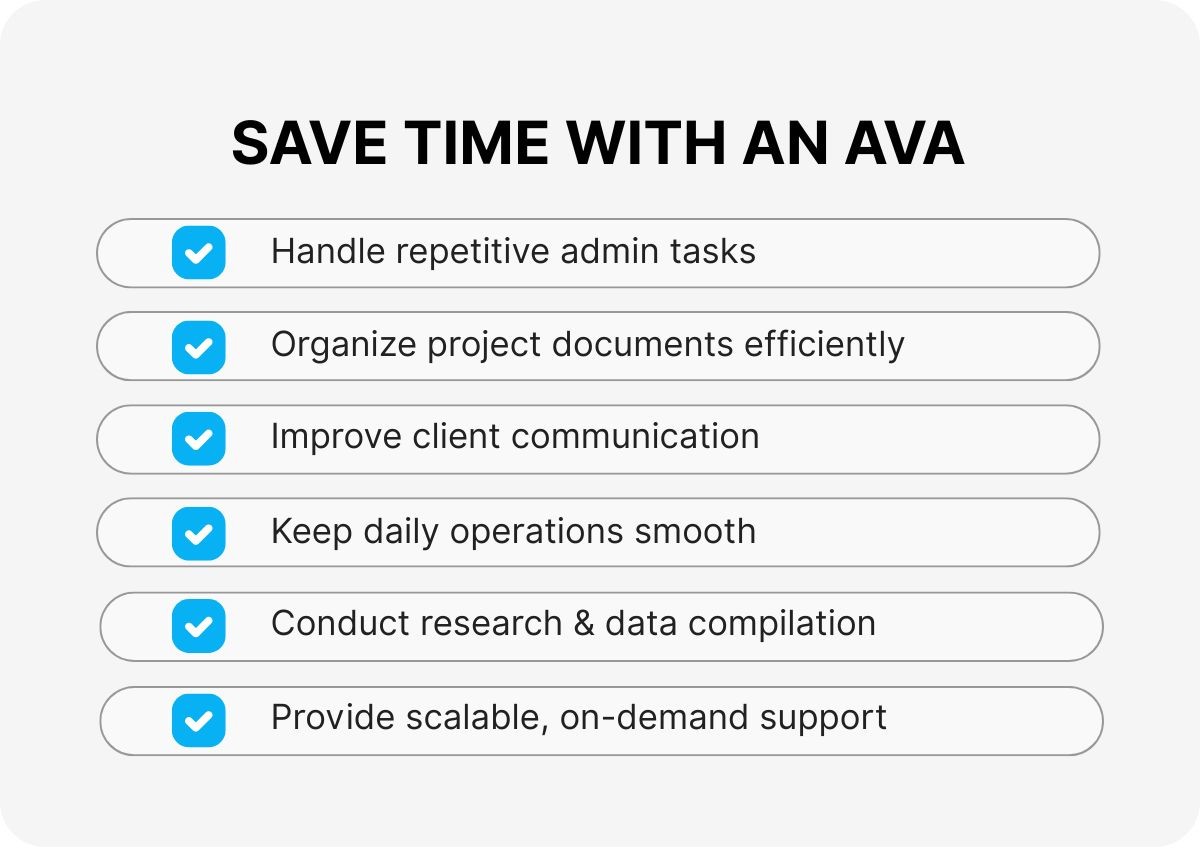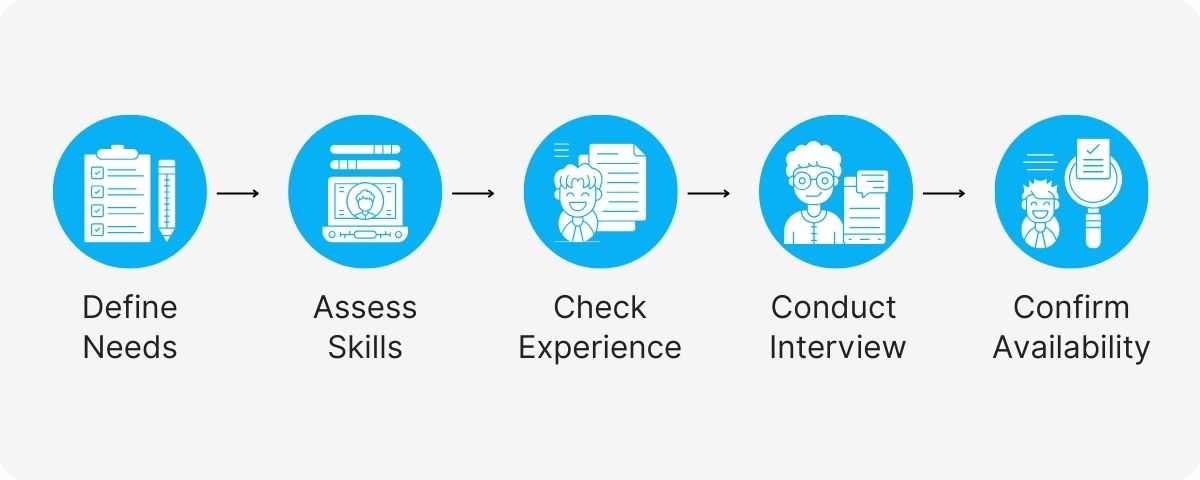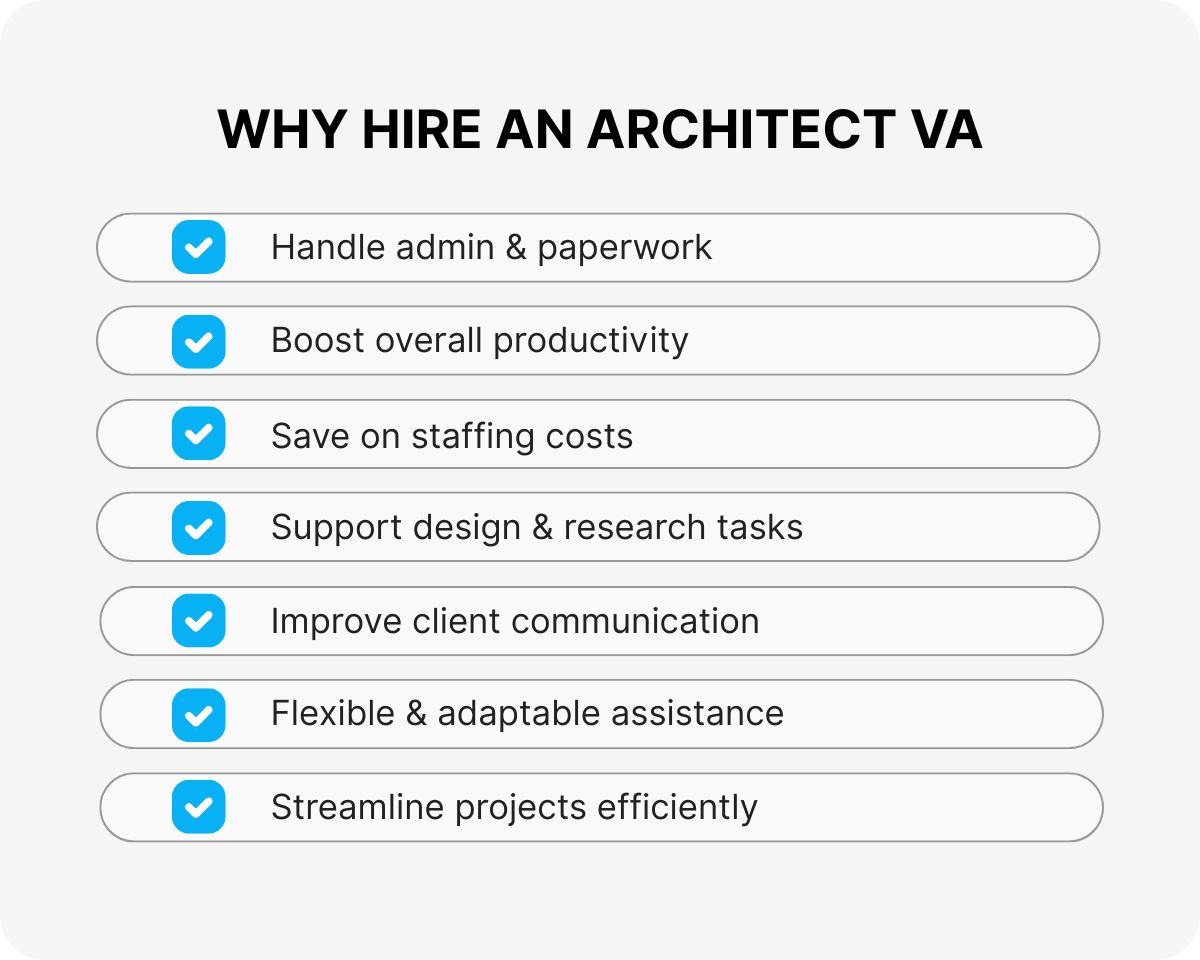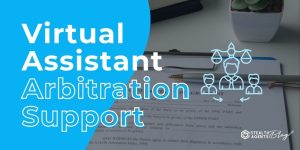Architecture virtual assistant services help architects streamline operations by handling time-consuming tasks like project scheduling, admin work, and client coordination. Stealth Agents provides highly trained AVAs so you can focus more on design and growing your firm efficiently and affordably.
Managing architectural projects can feel overwhelming with endless deadlines, client proposals, and administrative tasks piling up. An Architecture Virtual Assistant from Stealth Agents can take these time-consuming responsibilities off your plate, allowing you to focus on designing and growing your firm.
Many architectural businesses struggle with low lead generation and disorganized project management workflows, which can result in missed opportunities. Our skilled virtual assistants offer the perfect solution by handling tasks like client communication, scheduling, and drafting support, ensuring your operations run smoothly.
Research indicates that outsourcing administrative tasks can significantly reduce overhead costs and free up valuable time for your business. Whether you’re aiming to increase visibility or streamline your workload, our tailored services meet your firm’s unique needs. Start simplifying your day-to-day operations and growing your business by registering today for reliable, professional support.

What is an Architecture Virtual Assistant?
An Architecture Virtual Assistant (AVA) another word for virtual assistant is a specialized remote professional who supports architects and architectural firms in handling various administrative and operational tasks. These assistants are trained to understand the specific needs and demands of the architecture industry, providing services that help streamline workflows and enhance productivity. In this way, AVAs are valuable assets to architects and architectural firms, allowing them to focus on their core competencies while delegating time-consuming tasks.
Some everyday tasks that an AVA can handle include managing emails and appointments, preparing documents, conducting research, creating presentations, and organizing project files. They can also assist with marketing and communication efforts, such as maintaining social media accounts and responding to client inquiries. By taking on these responsibilities, they enable architects to concentrate on their creative design work.
Types of Virtual Assistants for Architectural Firms
Just as architects use the right tool for every job, not all virtual assistants (VAs) are created equal there’s a specialized VA to suit nearly every business need found in an architectural practice.
Here are some roles you might consider when building your support team:
- Administrative VAs: Masters at scheduling, document management, and keeping busy inboxes organized, they’re the digital equivalent of a Swiss Army knife, always useful.
- Business Support VAs: Focused on streamlining business processes, handling bookkeeping, coordinating proposals, or even assisting with RFPs and submissions.
- Customer Service & Call Center VAs: Perfect for firms juggling client inquiries, follow-ups, or appointment scheduling, ensuring your reputation remains as solid as that steel beam in your last project.
- Construction VAs: Familiar with industry lingo and project timelines, they help you keep contractors, timelines, and paperwork all in order.
- Data Entry VAs: No more manually logging hours of site visit data or survey results they’re precise, reliable, and ready to digitize your details.
- eCommerce & Real Estate VAs: For firms branching into property development or sales, these specialists can handle listings, client communications, and market research.
- Healthcare & IT Services VAs: For practices working in specialized sectors like healthcare or tech-integrated design, these VAs bring sector-specific knowledge to the virtual drafting table.
- Marketing & Social Media VAs: Marketing & Social Media VAs: From crafting project case studies to managing your LinkedIn and Instagram portfolios, these VAs help your work get noticed beyond the drawing board. An instagram virtual assistant can further enhance this by curating content, boosting engagement, and maintaining a consistent visual identity for your brand.
Enhancing Marketing Efforts with an AVA
Beyond handling the daily essentials, an Architect Virtual Assistant becomes an invaluable partner in elevating your firm’s marketing initiatives. From the ground up, they can help spotlight your expertise and grow your reach freeing up even more of your valuable time.
Here’s how an AVA can bolster your marketing arm:
- Researching potential clients, partners, and stakeholders to identify new opportunities
- Collecting and analyzing data about prospect preferences and project requirements, so your outreach feels tailored
- Drafting and designing polished marketing collateral think brochures, case studies, or eye-catching presentations—that showcase your firm’s best side
- Managing your presence on platforms like LinkedIn, Instagram, and X (formerly Twitter) by planning, scheduling, and posting content that keeps your brand front and center
- Engaging with your online community responding to inquiries, following up with comments, and building relationships
- Coordinating email campaigns and curating newsletters to keep prospective and current clients informed about your latest projects and insights
Key Responsibilities of an Architecture Virtual Assistant.
- Project Management: AVAs assist in managing project timelines, ensuring deadlines are met and milestones are achieved. Their involvement often leads to more organized and efficient project execution, ultimately improving client satisfaction. AVAs help mitigate risks and prevent costly delays by keeping projects on track.
- Administrative Support: They handle routine tasks such as scheduling meetings, organizing files, and managing emails, freeing up valuable time for architects. This enables architects to focus on higher-value activities, such as design and client engagement. Additionally, their organizational skills ensure that all administrative processes run smoothly and without interruption.
- Research: As part of their role, they conduct market research, gather data on materials, and stay updated on industry trends. This can provide architects with critical insights for innovative designs and competitive proposals. Regularly updating databases with the latest findings keeps the firm ahead of the curve in a rapidly evolving market.
- Document Preparation: AVAs can prepare detailed reports, create presentations, and draft communications, ensuring all documentation is professional and accurate. This meticulous attention to detail enables the AI to maintain its reputation for quality and precision. Well-crafted documents also enhance internal and external communications, fostering a professional image.
- Client Coordination: They can liaise with clients, contractors, and other stakeholders to ensure clear communication and smooth project execution. Effective client coordination is essential for establishing strong relationships and fulfilling project requirements. By acting as a reliable point of contact, AVAs help resolve issues promptly and maintain client trust.
- Software Proficiency: Many AVAs are skilled in using architectural software, such as AutoCAD, Revit, and SketchUp, enabling them to assist with design-related tasks. This technical expertise allows AVAs to make significant contributions to the design process, thereby reducing the workload on the primary team. Their proficiency in these tools ensures that design tasks are completed accurately and efficiently, supporting the overall creative vision.
Role of an AVA in Bid Preparation and Submission
Securing new projects in architecture often comes down to meticulous bid preparation, a process that can quickly eat into valuable creative time. Fortunately, an Architecture Virtual Assistant (AVA) can be instrumental in streamlining every step of this process.
Comprehensive Bid Management
AVAs adeptly manage the end-to-end bidding process by:
- Identifying Opportunities: Scouring resources for relevant projects, tenders, and RFPs that align with your firm’s expertise and goals.
- Analyzing Requirements: Carefully reviewing bid documents to ensure all submission criteria and evaluation guidelines are fully understood and met.
- Developing Bid Materials: Drafting clear, compelling sections like cover letters, executive summaries, and detailed project narratives, all in accordance with the outlined specifications.
- Coordinating Collaboration: Gathering essential input from architects, engineers, and consultants to assemble a cohesive, accurate bid package.
- Ensuring Accuracy and Compliance: Double-checking documents for correct formatting and strict adherence to submission protocols so nothing is overlooked.
Facilitating Seamless Submissions
Your AVA not only prepares documents but also:
- Curates Financials: Assists in organizing pricing strategies, calculating costs (materials, labor, overhead), and compiling all required figures.
- Monitors Deadlines: Keeps a close eye on submission schedules, coordinating uploads to digital portals or dispatching hard copies where needed.
- Tracks Outcomes: Maintains records of bids, communicates with clients, and prepares summary reports for both successful and unsuccessful submissions, providing insights that inform future proposals.
Why Choose a Virtual Assistant Over an In-House Assistant?
Opting for a virtual assistant tailored to the architecture industry brings a host of strategic advantages that go far beyond what a traditional in-house assistant can offer.
Here’s why making the switch can be a game-changer for any architectural practice:
- Access to Specialized Talent: Virtual assistants often come equipped with up-to-date knowledge of key industry software, think AutoCAD, Revit, or SketchUp and stay abreast of the latest architectural trends. This expertise allows them to contribute meaningfully to both administrative tasks and technical support.
- Unmatched Flexibility: Instead of being tied to a single work schedule, virtual assistants can provide support outside regular office hours and across time zones. This ensures urgent project needs or international client requests never fall through the cracks.
- Scalable Support: Project demands can ebb and flow. Virtual assistants offer the flexibility to increase or decrease their hours as needed, sparing you the logistical headaches of hiring or downscaling internal staff.
- Cost-Efficiency: Unlike an in-house assistant who comes with overhead expenses like workspace, equipment, and benefits virtual assistants are compensated only for their productive hours. This translates to significant cost savings without sacrificing service quality.
- Global Perspective: By hiring remotely, firms can tap into a geographically diverse talent pool. This can introduce new perspectives and creative ideas, enriching the collaborative process without the complications of relocation.
- Confidentiality and Professionalism: Reputable virtual assistants adhere to strict data security and confidentiality protocols, meaning your sensitive designs and client information remain safeguarded throughout every phase of the project.
- Preventing Burnout: With a virtual assistant to share the load, architects can offload routine but time-intensive tasks and devote more energy to creativity and client engagement. This balance helps maintain morale and drive throughout demanding project cycles.
Benefits of Hiring a Virtual Architectural Assistant.
-
Increased Efficiency: By delegating administrative tasks, architects can focus more on design and client interactions, ultimately enhancing their productivity. This shift enables them to deliver higher-quality work and maintain stronger client relationships.
-
Cost Savings: Hiring a virtual assistant can be more cost-effective than employing a full-time, on-site staff member. Firms can save on overhead costs, including office space, equipment, and benefits.
-
Flexibility: AVAs can work on demand, providing support when needed without the constraints of traditional office hours. This flexibility allows firms to scale their workforce according to project demands, ensuring optimal resource utilization.
-
Access to Expertise: Construction virtual assistants have specialized training and experience in architecture, bringing valuable insights and skills to the table. Their knowledge can enhance FIRM’s capabilities, resulting in improved project outcomes.
-
Enhanced Productivity: With routine tasks managed by an AVA, the core team can dedicate more time to creative and strategic activities. This can lead to faster project turnaround times and a more dynamic workflow.
- Scalability: As your firm grows, AVAs can easily adapt to increasing workloads and expanding responsibilities. This scalability makes it simpler to manage larger projects and take on new clients without the need for immediate staffing increases.
How Does an Assistant for Architecture Firms Save Time?
Managing an architectural business can be overwhelming even for the most organized firm when deadlines, client expectations, and detailed workflows pile up. Hiring an assistant for architecture firms helps you save time by handling time-consuming tasks while ensuring accuracy and efficiency. Here are six ways an architectural virtual assistant can help streamline your operations and free up your schedule.
1. Handles Repetitive Administrative Work For You
An architectural virtual assistant can manage emails, schedule meetings, and organize files so you don’t have to, ensuring nothing falls through the cracks. They take care of time-consuming tasks like billing clients, following up on invoices, or updating project timelines.
By managing these repetitive tasks, your assistant allows your team to focus on creative and technical work instead of paperwork. For firms dealing with tight deadlines, a trusted virtual architecture project coordinator ensures that administrative details are handled promptly and efficiently.
This not only reduces stress but also enhances overall productivity. More importantly, having an organized workflow guarantees your clients receive faster responses and better service. With less administrative clutter, you’ll have more time to focus on designing smarter and growing your business.
2. Prepares and Organizes Project Documents
Architectural projects involve numerous documents, including drawings, contracts, proposals, and reports, which can overwhelm your in-house staff. A virtual architect design assistant organizes all files, making it easy to locate critical information quickly and efficiently.
They prepare accurate drafts, review documents for inconsistencies, and compile presentations for clients and stakeholders. Having these tasks managed allows your architects and designers to focus on core responsibilities without distractions.
Additionally, a virtual architect assistant ensures every file is stored digitally and properly labeled, eliminating last-minute searches and lost documents. For businesses juggling multiple projects, this level of organization can save hours every week. With everything in place, your entire team can stay focused on deadlines and deliverables, rather than sifting through paperwork.
3. Improves Client Communication and Collaboration
A responsive client relationship is the backbone of every successful architecture firm, and a virtual architect assistant ensures you never miss a meaningful conversation. They handle initial client inquiries, provide project updates, and respond promptly to client feedback or concerns.
This streamlined communication eliminates delays that often lead to dissatisfaction or misunderstandings during projects. When acting as a virtual architecture project coordinator, they also oversee updates between clients, engineers, and contractors, ensuring all parties remain on the same page.
Their ability to manage these essential interactions ensures that workflows remain smooth and projects are completed on time. Clear, professional communication also builds trust with clients, making them more likely to recommend your firm to others. This reduction in back-and-forth communication saves you and your staff countless hours, enabling you to allocate time more effectively.
4. Keeps Daily Operations Running Smoothly
Managing operations in an architectural firm is time-consuming, especially when unexpected changes or urgent demands arise. Hiring an assistant for architecture firms ensures that daily tasksfrom setting up virtual meetings to updating budgets are handled consistently.
They use project management tools to assign deadlines, track progress, and identify bottlenecks before they escalate into disruptions. A reliable architectural virtual assistant will address these operational gaps, ensuring that every part of your team’s workflow operates smoothly without delays.
For example, they can review project milestones and remind team members before deadlines arrive. This consistency minimizes the risk of mismanagement while freeing senior staff to focus on design and strategy. Delegating operational tasks to an expert ensures you save significant time without sacrificing quality.
5. Supports Time-Consuming Research and Data Compilation
Architectural projects often require gathering market data, zoning laws, and material specifications, which consume valuable hours that your team could use on design. A virtual architect design assistant conducts this research, compiles the findings, and presents them in clear formats like spreadsheets or summaries.
They also investigate competitor projects, industry trends, or potential cost-saving opportunities that can benefit your firm. When working with a virtual architecture project coordinator, your research needs are managed systematically and delivered on time.
This attention to detail allows your firm to make well-informed decisions without wasting resources on lengthy searches. With this kind of support, your architects and leadership team can focus on taking action rather than wasting time on preparation. Gaining accurate information with minimal effort leads to better outcomes for both your business and its clients.
6. Offers Scalable and On-Demand Support
One of the most excellent time-saving benefits of a virtual architect assistant is their flexibility to provide help only when you need it. Whether you’re scaling during peak seasons or managing a complex project, they adapt to your requirements without the long-term commitment of hiring permanent staff.
A virtual architecture project coordinator can jump in to manage workflows or assist with specialized needs as projects demand. They fill in the gaps, allowing your core team to stay focused on priorities rather than spreading themselves thin.
By offering scalable support, you only pay for the specific services or hours required, making it a cost-effective and time-saving solution. The freedom to use virtual assistance only when necessary ensures your firm can adapt quickly to changing project demands and deadlines.
Hiring an assistant for an architecture firm ensures your team can work smarter, more efficiently, and with less stress. Their ability to take on tedious tasks, manage communication, and keep projects moving not only saves you time but also helps your business grow. With their tailored support, you can focus on what matters most: delivering creative, high-quality designs that clients love.
What Results Can I Expect From Hiring an Assistant for Architecture Firms?
Hiring an assistant for architecture firms delivers measurable results by saving time and increasing efficiency across your business operations. A skilled architectural virtual assistant manages tedious tasks like scheduling, client communication, and document organization, giving your team more time to focus on their creative and technical strengths.
For firms struggling with drafting or technical drawings, a virtual architect design assistant or MEP drafting virtual assistant prepares precise drafts and eliminates common errors, ensuring smoother project execution. Delegating coordination duties to a virtual architecture project coordinator improves communication between designers, contractors, and clients, preventing delays and costly misunderstandings.
Additionally, an architectural virtual assistant provides research and compliance support, gathering zoning laws and material options so that your architects can make informed decisions without interruptions. Businesses using outsourcing for architecture see cost savings since hiring virtual assistants eliminates expenses tied to onboarding and full-time employees.
With the assistance of virtual assistants for architects, firms can experience streamlined workflows, increased productivity, and stronger client relationships, ultimately ensuring long-term growth and success.
How Do Virtual Architect Assistants Improve Design Workflows?
Managing architectural workflows can be draining due to the numerous overlapping deadlines, client revisions, and complex designs that need to be overseen. A virtual architect assistant can take on many of these tasks, allowing you and your team to focus on your creative and technical strengths. Below are five ways architectural virtual assistants enhance design workflows, saving you time and resources.
1. Organizing Project Timelines and Deadlines
Time management is critical in architecture, and a virtual architecture project coordinator ensures that nothing slips through the cracks. They create detailed schedules, update timelines when changes occur, and remind you of key deadlines so your projects stay on track.
For instance, they can manage overlapping phases, ensuring you allocate time properly between initial designs and approvals. Their ability to streamline schedules results in fewer delays and improved client satisfaction. Additionally, they collaborate with contractors and vendors to coordinate timelines and prioritize revisions.
Having their organizational support helps you focus on high-value tasks without constantly worrying about project pacing. This not only saves time but also maintains a steady and predictable workflow.
2. Managing Revisions and Client Feedback
Revisions are an inevitable part of architectural work, and managing them without distraction can be tough. A virtual architect design assistant can handle organizing client feedback, tracking requested changes, and updating documents accordingly.
These assistants ensure that all feedback is carefully integrated into ongoing designs, minimizing errors and missed instructions. They also communicate directly with contractors and clients, ensuring everyone stays aligned during revisions. If you work with a virtual assistant for architecture firms, they can also prepare summaries of updates so you’re not combing through emails or notes.
This streamlined process ensures revisions happen efficiently, without draining our team’s productivity. By managing feedback more effectively, you save hours of back-and-forth communication, speeding up the project timeline.
3. Streamlining Drafting and Design Preparation
Drafting demands focus, but balancing it with daily tasks can slow you down. A virtual construction drafting assistant or MEP drafting virtual assistant helps you prepare drafts, input changes, and organize CAD files for seamless collaboration a valuable aspect of construction outsourcing services that enhances efficiency and workflow.
They assist in creating detailed technical drawings, ensuring all requests and measurements are accurate from the start. Virtual assistants are also trained to review drawings for inconsistencies, reducing the risk of costly on-site errors. By alleviating drafting-related tasks, your team can focus on developing innovative designs while all administrative drafting needs are met.
Additionally, their expertise in construction documentation ensures that your projects are well-prepared for every phase. A streamlined drafting process removes bottlenecks, saving your firm both time and resources.
4. Coordinating Across Teams Efficiently
An architectural project involves multiple teams from designers to contractors and engineers which means coordination often eats into design time. A virtual architecture project coordinator serves as a central point of contact, ensuring smooth communication between all stakeholders.
They relay updates, share necessary documents, and handle meeting logistics, letting your team focus on their specialization. Virtual assistants also use project management tools to track progress and identify bottlenecks early. This comprehensive oversight keeps all moving parts aligned, preventing errors caused by miscommunication.
Orchestrating Virtual Meetings and Video Conferences
Virtual assistants excel at organizing virtual meetings and video conferences—two modern necessities for keeping dispersed project teams and clients connected.
They schedule meetings, send invitations, and coordinate logistics using user-friendly tools like Calendly or Google Calendar.
When unexpected technical glitches pop up, a skilled assistant can troubleshoot on the spot, keeping meetings running smoothly.
During calls, they interact professionally with clients, partners, or stakeholders and frequently take meeting minutes, summarize discussions, and follow up on action items so nothing slips through the cracks.
Their knack for creating and formatting presentations in PowerPoint or Google Slides ensures every meeting is clear and on point, with visually appealing and well-organized content.
Their expertise extends beyond coordination to troubleshooting client queries or on-site requirements, further reducing backlogs. With their help, processes flow effortlessly, keeping all teams working in harmony.
5. Managing Research and Administrative Tasks
Projects often require meticulous search, whether it’s sourcing materials, analyzing competitors, or studying competitors’ work. Virtual assistants excel at these tasks, compiling information, summarizing findings, and presenting them to your team clearly and concisely in various formats.
For example, a virtual construction assistant can research building materials or locate cost-effective vendors, saving your in-house team valuable time and effort. Delegating this task allows architects and designers to work on designs without pausing for time-consuming details.
Additionally, an architecture content producer virtual assistant can create engaging reports or documents for clients based on research results. They handle this work efficiently and ensure your team has everything they need to make informed decisions. By removing the burden of research and admin tasks, these assistants free up immense time for creative workflows.
6. Customizing Support to Fit Your Workflow
No two architecture firms are worth the same way, and that’s where virtual assistants shine by providing tailored services. A highly skilled architect virtual assistant adapts to your existing systems, whether you use AutoCAD, Revit, or other platforms, ensuring seamless integration.
They support your workflow at any point, whether preparing proposals, updating client portals, or finalizing project phases. For firms utilizing outsourcing for architecture, virtual assistants are a flexible option that scales support based on demand.
If your team is handling multiple projects, they prioritize tasks to ensure deadlines are met without compromising quality. This personalized approach enables your firm to remain productive, regardless of the workload. Their flexibility proves especially useful during peak seasons when additional help becomes essential.
Hiring a virtual architect assistant is the key to transforming chaotic processes into efficient design workflows. They take on critical back-end tasks, improve collaboration, and help you meet deadlines, freeing your team to focus on what matters most. With their support, your firm can deliver consistently outstanding designs, ensuring clients continue to come back.
How to Choose the Best Architecture Virtual Assistant?
1. Define Your Needs
Start by clearly defining what tasks you need the VA to handle. This could range from CAD drafting and 3D modeling to project management and client communications.
Make a list of the specific responsibilities and outcomes you expect.
Additionally, specify the expertise required for each task to ensure the VA can meet your expectations.
Defining these needs upfront will streamline the selection process and help find the perfect match.
2. Assess Technical Proficiency
Given the specialized nature of architecture, the VA provides technical proficiency in the required software and tools, such as AutoCAD, Revit, SketchUp, and industry-standard programs.
Ask them to provide examples or a portfolio showcasing their work with these tools.
You might also consider giving them a small test project to assess their skill level before committing.
3. Verify Experience and Expertise
Look for virtual assistants (VAs) with relevant experience in architecture or engineering. They should have a proven track record of handling similar tasks and projects. Check their portfolio and request references or testimonials from previous clients. Additionally, inquire about their experience with different types of architectural projects (residential, commercial, etc.) to ensure they are well-rounded and versatile.
4. Professional Qualifications
Ensure that the VA has the necessary educational background and certifications relevant to architecture. This adds credibility and assures you they have formal field training. Certifications from recognized institutions or professional bodies can be a good indicator of their dedication and expertise. Always verify their qualifications to avoid any potential misrepresentation.
5. Communication Skills
Effective communication is key, especially if the VA interacts with clients or team members. Evaluate their ability to convey ideas, provide updates, and understand project requirements. Consider their proficiency in your preferred language and responsiveness to messages and inquiries. Strong communication skills help mitigate misunderstandings and keep projects on track.
6. Cultural Fit
Consider how well the VA fits into your company culture. This can impact collaboration and overall productivity. Schedule an interview to gain insight into their work style and the company’s values, and determine if the A’s approach and attitude align with your company’s values. A good cultural fit can lead to a more harmonious and effective working relationship.
7. Cost and Availability
Determine the VA’s pricing structure and ensure it aligns with your budget. Also, confirm their availability to ensure they can dedicate the necessary time to your projects. Project’s timeline and critical deadlines to avoid scheduling conflicts. Understanding their workload and availability will help determine if they can dedicate sufficient attention to your project.
8. Due Diligence
Lastly, do thorough background checks. Look at reviews, testimonials, and any potential red flags. This step helps avoid future issues and ensures you partner with a reliable professional. Conduct interviews and possibly a trial period to observe their performance firsthand. Doing your due diligence can save time and resources in the long run.
Why Does a Business Owner Hire an Architect?
If you’re a business owner, you know time is precious, and managing tasks efficiently can often be overwhelming. That’s where an architect’s virtual assistant can make all the difference. Hiring one frees up your schedule, increases productivity, and ensures your project runs smoothly.
Here’s a list of reasons why wiring one could be the smartest choice for your business.
1. They Handle Time-Consuming Administrative Tasks
Architectural projects often involve endless paperwork, emails, and follow-ups, which can steal time from your creative work.
An architectural assistant can handle scheduling, document preparation, and correspondence, allowing you to focus on designing.
They can efficiently organize files and handle billing, reducing stress for you and your team.
With the help of a virtual assistant for architects, deadlines are easier to meet because tasks are handled promptly and efficiently.
This support is vital for keeping your projects running without unnecessary delays.
2. They Boost Overall Productivity
When you work with a virtual architect assistant, you can delegate tasks, knowing they will be done well.
These professionals specialize in completing assignments like drafting contracts, organizing project blueprints, and updating databases.
Tasks you once had to juggle are now expertly handled by an architectural virtual assistant, giving you room to focus on growing your business.
Small details often slow you down, but an architectural assistant ensures nothing gets overlooked.
Productivity skyrockets when you have an assistant for architecture firms managing the background work.
3. They Save You Money
Instead of hiring a full-time employee, you can hire a virtual assistant architecture professional when needed.
They offer the same expertise at a fraction of the cost, providing flexibility for your budget.
Outsourcing work to a virtual assistant architect eliminates expenses like office space, equipment, and benefits.
Hiring these assistants often involves using architecture outsourcing, saving you from the hassle of managing extra team members in-house.
Many businesses also prefer working with professionals from regions like the Philippines, where skilled virtual assistants offer high-quality work at affordable rates.
4. They Support Design Tasks and Research
A virtual architect design assistant can assist with essential design responsibilities, like creating drafts or refining blueprints.
They are also skilled in conducting market research, sourcing materials, and coordinating with suppliers, which helps you meet client needs.
Outsourcing these tasks allows you to stay focused on the big picture while remaining informed about industry trends and updates.
Many business owners choose virtual assistants for architecture firms because these assistants are highly trained in software like AutoCAD and SketchUp.
Having a virtual architect assistant work on designs lets you focus on your projects’ more significant, strategic elements.
5. They Improve Client Communication and Satisfaction
Communication is a crucial part of any architectural project, and clients expect prompt responses and regular updates.
A virtual assistant architecture expert can monitor client inquiries, ensuring that no emails or calls are overlooked.
They also help prepare presentations, reports, and updates for clients, which is essential to maintaining strong relationships.
By having a reliable virtual assistant for architects, you can deliver projects on time and with clarity, earning more trust and positive feedback.
Happy clients lead to where an architecture assistantship pays off.
6. They Are Flexible and Adapt to Your Needs
Unlike in-house employees, virtual assistants work on your terms, adjusting their approach based on your tasks or workload.
Whether you need support for short-term projects or regular assistance, they can deliver results.
Many virtual assistants for architects are skilled in various tools and software, making them versatile for different needs. Firms’ requirements, scaling their responsibilities up or down, are our priority.
This adaptability makes hiring a virtual architect assistant valuable for long-term growth.
7. They Help Streamline Projects with Specialized Knowledge
Managing complex projects can be stressful, especially when it involves balancing design, budgets, and timelines. simultaneously
A virtual assistant architecture specialist has the expertise to coordinate with contractors, track expenses, and organize timelines.
Virtual assistants can also report project progress, helping you identify areas for adjustments.
Many businesses hire virtual architectural assistants specifically because their skills help projects stay efficient and within budget.
Their specialized knowledge complements your expertise, ensuring every aspect of the architecture process is as smooth as possible.
Why Choose Stealth Agents?
We understand the unique challenges businesses face and are committed to providing solutions to their specific needs, which is why Stealth Agents stands out:
1. Experienced Professionals
Our IT virtual assistants are highly skilled and experienced in various industries. They undergo rigorous screening to ensure they can deliver top-notch service. Each candidate is evaluated for their technical abilities, communication skills, and problem-solving capabilities, ensuring that you receive only the best talent to support your business needs. With Stealth Agents, you gain access to professionals who can hit the ground running and make an immediate impact.
2. Customized Solutions
We work closely with you to understand your business requirements and match you with a virtual assistant who fits your needs perfectly. Our tailored approach ensures that the virtual assistant is not only proficient in the required tasks but also aligns with your company culture and goals. This personalized matching process guarantees that you receive targeted support that enhances productivity and efficiency.
Our process starts by thoroughly discussing your firm’s unique needs, project goals, and workflow pain points. We don’t believe in a one-size-fits-all approach every architectural business operates differently, so we take the time to understand exactly what you require.
Whether you need assistance with managing complex project timelines, coordinating with contractors, or handling specialized software, we pair you with a professional who brings the right expertise to the table.
Throughout the onboarding process, we maintain open communication to ensure your new virtual assistant is a seamless fit. Need to scale responsibilities up or down as your firm grows? We’re flexible and ready to adjust.
Plus, with a trial period available, you have the opportunity to experience the value firsthand and confirm the match before committing long-term.
Our commitment: You get a solution that not only meets your day-to-day requirements but also supports your strategic growth delivering measurable results where you need them most.
3. Transparent Pricing
We offer clear and competitive pricing options, ensuring you get the best value for your investment. There are no hidden fees or unexpected costs, making it easy for you to budget effectively. Our flexible pricing plans cater to businesses of all sizes, allowing you to scale services up or down based on your current needs and financial considerations.
4. Dedicated Support
Our team is dedicated to ensuring a seamless integration of virtual assistants into your operations. We provide continuous support to address any concerns and ensure smooth collaboration. From onboarding to ongoing management, we are here to assist you every step of the way. Our commitment to proactive communication and problem-solving helps create a harmonious working relationship that maximizes the benefits of having a virtual assistant.
Takeaways
In today’s competitive architectural landscape, maximizing efficiency and productivity is essential. An Architecture Virtual Assistant offers an innovative solution to manage your administrative tasks, streamline project coordination, and enhance client communication. By delegating these responsibilities to a skilled virtual assistant (VA), you can focus on your core strength, creating innovative and impactful designs.
The benefits of hiring a virtual assistant are clear: reduced workload, improved time management, and cost-effective support. Whether a solo architect or managing a large firm, an Architecture Virtual Assistant can help you stay organized, meet deadlines, and provide exceptional service to your clients.
Investing in a Virtual Assistants means investing in your firm’s future. Embrace the opportunity to optimize your operations and elevate your architectural practice. Start experiencing the advantages of an Architecture Virtual Assistant today, and watch your business thrive.
Frequently Asked Questions
What are architecture virtual assistant services?
Architecture virtual assistant services are remote helpers for architects and their teams. They handle tasks like scheduling, organizing files, talking to clients, managing documents, researching designs, and preparing bids. They also use tools like AutoCAD and Revit to help with design work, saving time and money for architects.
How do architecture virtual assistants help with project management?
They keep track of project schedules, make sure deadlines are met, and organize important documents. They also help communicate with clients, contractors, and team members to keep everyone on the same page. This helps avoid delays and lets architects focus on designing instead of managing paperwork.
What software skills do architecture virtual assistants have?
They know how to use tools like AutoCAD, Revit, and SketchUp for design work. They also use programs for managing projects, organizing files, and staying in touch with teams. These skills help them create drawings, manage files, and keep everything accurate and organized.
Why should architects hire virtual assistants instead of in-house staff?
Virtual assistants cost less because you don’t have to pay for office space, equipment, or benefits. They can work from anywhere, adjust to your schedule, and help with specific tasks when needed. You also get access to skilled workers from around the world.
How do architecture virtual assistant services save time for firms?
They take care of everyday tasks like answering emails, scheduling meetings, and organizing files. They also prepare documents, do research, and talk to clients. This gives architects more time to focus on designing and working with clients instead of doing routine tasks.
What types of virtual assistants work with architecture firms?
There are different kinds of virtual assistants for architecture firms. Some handle office tasks like scheduling and organizing files. Others help with bookkeeping, writing proposals, or managing construction timelines. Some focus on marketing, like running social media or reaching out to clients.
How do architecture virtual assistants improve client communication?
They answer client questions, give updates on projects, and share feedback between clients and the team. They also help keep everyone informed, which avoids confusion and builds trust. This lets architects spend less time on emails and more time on their work.
What marketing support do architecture virtual assistant services provide?
They help with marketing by finding new clients, creating brochures, managing social media, sending emails, and writing newsletters. They also share the firm’s work online to attract more attention and bring in new projects.
How do architecture virtual assistants help with bid preparation?
They handle the bidding process by finding project opportunities, reading requirements, and putting together bid documents. They make sure everything is submitted on time and track the results. This saves architects a lot of time and effort.
What results can firms expect from architecture virtual assistant services?
Firms can get more done, save money, and have more time for creative work. Virtual assistants help make things run smoothly, improve client relationships, and take care of tasks that would otherwise slow down the team. This allows firms to take on bigger projects without hiring more full-time staff.


